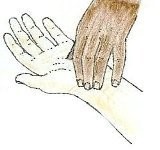Resource 3: Heart rate
![]() Background information / subject knowledge for teacher
Background information / subject knowledge for teacher
Heart rate is a term used to describe the frequency of the cardiac cycle. It is considered one of the four vital signs. Usually it is calculated as the number of contractions (heartbeats) of the heart in one minute and expressed as ‘beats per minute’ (bpm).
When resting, the adult human heart beats at about 70 bpm (males) and 75 bpm (females), but this varies. However, the reference range is nominally between 60 bpm (if less, termed bradycardia) and 100 bpm (if greater, termed tachycardia). Resting heart rates can be significantly lower in athletes. The infant/neonatal rate of heartbeat is around 130–150 bpm, the toddler's about 100–130 bpm, the older child's about 90–110 bpm, and the adolescent's about 80–100 bpm.
The body can increase the heart rate in response to a wide variety of conditions in order to increase the cardiac output (the amount of blood ejected by the heart per unit time). Exercise, environmental stressors or psychological stress can cause the heart rate to increase above the resting rate.
Measuring heart rate

The pulse rate (which in most people is identical to the heart rate) can be measured at any point on the body where an artery is close to the surface. Such places are wrist (radial artery), neck (carotid artery), elbow (brachial artery), and groin (femoral artery). The pulse can also be felt directly over the heart. (Remember, never use your thumb to measure your pulse rate, because thumbs have a pulse rate of their own.)
It is also possible to measure heart rate acoustically, by listening to the sounds the heart makes while beating. These sounds can be listened to using a stethoscope.
Resource 2: How mind maps can help mathematics teachers and pupils



